
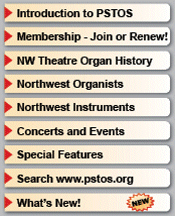
|

Lee Bauscher Residence - 3/11 Wurlitzer
Seattle, Washington
Organ installation timeframe: 1965 - 1984
Back to the Northwest Theatre Organ History: Residences page
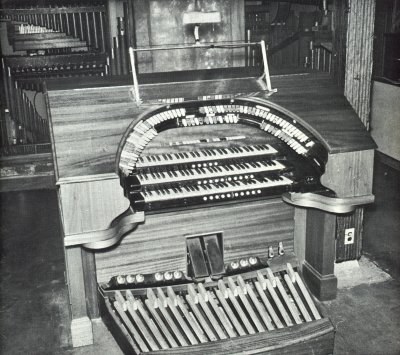
Lee Bauscher's instrument was originally installed in the World Theatre - Omaha, Nebraska. It was damaged in a serious fire at the theatre and Lee spent several years rebuilding it. According to Andy Anderson, the Bausher pipe chambers were 12 feet in height.
 Editor's Note: Various articles about the instrument (including the one below) list the Wurlitzer opus number as 1709. This disagrees with the Judd Walton Opus List which shows the World Theatre instrument as opus 530. It shows opus 1709 going to the Orpheum Theatre (also in Omaha). In a letter to the Editor of Theatre Organ (February 1970), Judd Walton himself also calls into question the accuracy of opus #1709. He states that the correct opus number is #530. Editor's Note: Various articles about the instrument (including the one below) list the Wurlitzer opus number as 1709. This disagrees with the Judd Walton Opus List which shows the World Theatre instrument as opus 530. It shows opus 1709 going to the Orpheum Theatre (also in Omaha). In a letter to the Editor of Theatre Organ (February 1970), Judd Walton himself also calls into question the accuracy of opus #1709. He states that the correct opus number is #530.
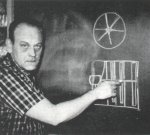 |
An electronics engineer by profession, Lee gained his pipe organ knowledge working as an apprentice organ maintenance man in Pennsylvania during his late teens.
Together with Bob Jones, Lee participated as a lecturer for a series of PSTOS technical seminars about theatre pipe organs. |
Lee's organ was eventually bought by Jerry Gould of Maple Valley in 1984 and disbursed for parts. The three-manual console was sold to the late Cal Christensen of Salt Lake City, Utah. Cal enlarged the console to four manuals.
The following article is from Theatre Organ, December 1968 (V10 No6), pp5-7:
From PIT to EPITOME
... or 'You WILL Play Again, Opus 1709!
STORY: Val Bauscher ˇ PHOTOS: Ed Zollman, Lee Bauscher
When the Lee Bauschers, of ATOE's Puget Sound Chapter, first purchased their Wurlitzer, wife Val was neutral in her reaction, went along simply because hubby Lee wanted to do this "crazy" thing. Now after three years of supplying gallons of coffee and everything from dawn-to-midnight chamber snacks to full dinners and crash duty work-parties, she is one of the instrument's most active supporters, thinks nothing of inviting 50 non-ATOE friends to meet the organ. Here she answers some of the "typical" questions encountered.
Q. Do you really have a pipe organ in your basement?
A. Yes, we do.
Q. Where in the world did you find it and how did you happen to buy it in the first place?
A. Lee has always had this "thing about pipe organs" since he helped someone work on them in his home town, Reading, Pa., while he was still in school.
I can't really say how he found out about this one .... I came home from a meeting one night and was informed that he could secure this priceless object, if he acted fast. This was late April, 1965. In May he received some pix in the mail showing it in the theatre-boarded up, covered with plaster, abandoned and unlovedˇ In ]une IT was delivered by Allied Van Lines and it took six men five (5) hours to unload and stack in the basement, on the covered patio, the neighbor's garage and any other empty spot around the house.
Q. And what did you think of your prize package?
A. Not much and mostly negative, although I tried not to show it too much... but when I took a long, hard look at all that jumble of "junk" -- assorted pipes, chests and other unknown, to me, parts -- I was thoroughly disheartened.
There it was piled with no rhyme or reason, dirty, decaying in varying stages of dilapidated deterioration. I overheard one of the fellows remarking that this was surely a "basket case" and I privately wondered why we didn't just bury the whole thing in the "pit" along with the dead rat they found in the console.
Q. Have you since changed your mind?
A. Oh, sure. I knew from past experience that this was going to be another case of "love me--love my dog." My husband was sold on the idea and already in his mind's eye had it playing the "sweetest music this side of Guy Lombardo." Later on so many friends became so interested in the project that I was caught up in the excitement and made a 180° and now, 3-1/2 years later, it's 'tour beautiful baby" and featured in THEATRE ORGAN BOMBARDE.
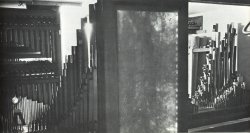 |
COLOR ORGAN, behind translucent panel between Main and Solo chambers, converts organist's audio into visual. Two ceiling-mounted mikes, lined up in front of each chamber, pick up the sound and convey it to 42 colored bulbs, mounted in pattern, 21 to each side of a crinkled foil reflector. |
Brilliance is controlled by force of the impulse and frequency of notes determines the color--base notes control blue bulbs; mid-range, red; and high frequency notes, green.
Q. You mentioned friends helping; is there any one person or persons who contributed more than others?
A. Not really. The whole restoration team was made up of avid ATOE members who took this on as their own project. They ranged from the business friend who was installing an organ in his own home when time permitted, to the busy housewives who recovered some 2,000 pneumatics at home, to our young friend, Scott, who removed the old membrane from the pneumatics in the first place. The busy businessman spent most of his vacation with us, boring thousands of holes in the new relay. He also did the final finish on the chamber floor, finishing at 3 a.m. Thanksgiving morning. They poured the cement over Visqueen.
Q. What would you say it has cost you to secure, ship, repair and install this instrument?
A. I wouldn't try to guess-timate. Firstly, neither one of us would believe it, and secondly, there is no price you can place on the work of friends, without whom this could never have happened. I can say that a local reputable firm advised our banker that it would take in excess of $20,000 to replace it as it stands.
Q. What would you say the high spots have been in the installation process?
A. We mark the milestones by parties. Christmas, 1965, Lee had one (1) rank (hay)wired and played "Silent Night." The following December we had (3) parties. The sneak prevue and "thank you party" for 25 couples who had helped in various ways. My office party, where we had no organist but everyone was in a gay mood and a piano-playing secretary did a swinging job. The third party was a 25th wedding anniversary for two faithful workers. The organ was "Great!" Well, it was making sounds, wasn't it?
By 1967 all 11 ranks were playing, and the same friends were back to help us appreciate the improvement that had been made in refining the instrument. This is the year we started work on the color organ. Lee had wired up the circuit and I poured the plastic panel, neither one of us knowing what the other was striving for. It was a happy balance when finished.., well, not really finished ... but enjoyable. Our biggest thrill came when Eddie Dunstedter dropped by to try it after one of his concerts here.
This year... Who knows... Things are brewing and there are still a few more days.
Q. Do you intend to get down there and help physically on this?
A. NO! But I have installed a commercial coffeemaker and have a supply of moose-burgers in thc freezer.
From PIT...
"Poor old '1709'! She'll never play again!" "Cheez! Did you see all the plaster in those pipes? And that relay ...!" These and other remarks, less printable, were among those heard coming from the sturdy group of ATOE Puget Sound Chapter members and friends as they filed out of Val and Lee Bauscher's basement, where they had just respectfully deposited the battered remains of a Wurlitzer Style 235 Special, that gloomy summer day in 1965...
Soon after, however, Lee Bauscher's "Pennsylvania Dutch" determination took over, and the well-known long, hard haul began. And NOW- 25 gallons of shellac, 7 gallons of Elmer's, 5 gallons of contact cement, 500 new magnets, some 60 sheets of zephyr skin, 1600 gallons of coffee and innumerable round-the-clock meals and snacks, and x-number of work-hours and moolah-skins later- Opus 1709 IS playing again.
The following word-and-picture story gives some of the highlights.
A one-piece mahogany air trunk, 18" square and 24' long, and with regulators mounted directly on top--serves both chambers: the Main with 8"--the Solo with 12"--pressure. The six ranks of the Main chest are run on two 4" polyethylene plastic "sewer pipe" lines directly from the regulator.
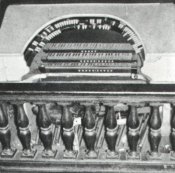 |
THE CONSOLE--shown here in the theatre before removal, yielded the usual crop of popcorn and chewing-gum balls--as well as the remains of a rat which had lunched his way through the stop-rail, wiping out all leather en route. Five layers of paint were removed: the final creme-with-gold-flecks; a late 30's bilegreen; dark brown; white; silver and the original Wurlltzer mahogany. Wurlitzer apparently used 1/32" veneer in 1927, for it too came off with the paint remover, requiring a complete re-veneering of the entire console. |
In the process Lee discovered a possible way to obtain precise construction data: under the veneer on upper left-hand recessed veneer panel he found the construction date to be 1924 whereas Wurlitzer records show theatre installation in 1927. Because of the stoplist and apparent add-ons in the relay, Lee suspects his organ was first installed in a church, then repossessed and transferred to the World Theatre.
|
THE MAIN CHEST in the theatre, showing water and plaster damage. A note on the back of the picture reads: "... this looks like hell! We'll leave the plaster in Omaha." But they didn't! Generous deposits were dug from interior of chests and pipework in early stages of rehabilitation effort. |
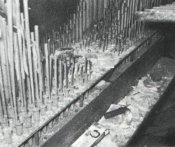 |
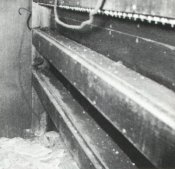 |
THE RELAY--Note extensive water damage, necessitating completely new relay. Bauscher's boyhood training in the family woodworking business paid off here: he built from scratch an exact duplicate, but in Philippine mahogany, of the damaged Wurlitzer relay--boring some 20,000 holes in the process. (Friend and fellow ATOEer Ray Whelpley, who helped build the relay, also required a new relay, so the dauntless pair dashed off another duplicate for Ray's organ!) |
Lee also built or rebuilt the 2nd-touch relay; 50% of the Bourdon chest; one Tibia and two Flute pipes; three bottom-boards on the Main side and four top-boards with plenums.
|
THE "FUN" BEGINS -- Simultaneously with the digging and construction of the chambers, work on console reconditioning was begun. In addition to the new veneer job, console was completely releathered and rewired--indications of the meticulous work and loving care which went into the project. |
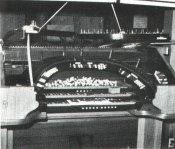 |
To EPITOME...
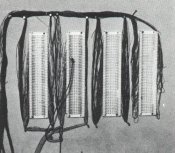 |
TERMINAL BOARDS of the new punch-in variety, by Graybar Electric, were used to pick up the wires from the chests; they require no soldering, peeling or twisting--simply punch in and they're connected. At the relay-room end, the wires terminate in scrapped telephone company cable and 50-pln Blue Ribbon Amphenol connectors, used throughout for connection between main terminal boards and switchboard. Thanks to this innovation, a rank can be unplugged and another connected in about 20 seconds! |
|
RELAY REBUILD--Friend and fellow ATOEer Ray Whelpley helped Bauscher with the formidable task of building a new relay to replace one damaged by water in the theatre. Some 20,000 holes were drilled in this process. Undaunted, the pair proceeded to dash off a duplicate relay for Ray's organ--also now nearing completion. |
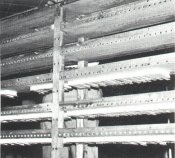 |
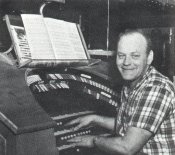 |
LEE BAUSCHER, usually found in shop or chamber, here relaxes at the console of his now completed 3-11 Wurlitzer. Photo by the Seattle Times
|
|
BAUSCHER SOLO CHAMBER, minus deposits of plaster and water damage accumulated in the theatre, stands glistening and ready to wail. Seen, front to back, are portions of the Vox Tibia, Tuba, Kinura and Tuba Profunda ranks. Mounted on the ceiling to the rear of the chamber are the Chimes and the Toy Counter. |
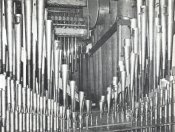 |
STOPLIST OF LEE BAUSCHER 3-11 WURLITZER
Style 235 Special--Opus 1709
Installed August 27, 1927, World Theatre, Omaha, Nebraska
Pedal
16 Tuba Profunda
16 Diaphone
16 Bourdon
8 Harmonic Tuba
8 Diaphonic Diapason
8 Tibia Clausa
8 Clarinet
8 Cello
8 Flute
4 Octave
16 Piano
Pedal traps
Bass Drum
Kettle Drum
Crash Cymbal
Cymbal
Solo
16 Tuba Profunda
16 Diaphone
8 Harmonic Tuba
8 Diaphonic Diapason
8 Tibia Clausa
8 Kinura
8 Orchestral Oboe
4 Harmonic Clarion
4 Octave
Cathedral Chimes
Xylophone
Glockenspiel
Orchestra Bells
|
Accompaniment
16 Contra Viol (T.C.)
16 Vox Humana (T.C.)
8 Harmonic Tuba
8 Diaphonic Diapason
8 Tibia Clausa
8 Clarinet
8 Kinura
8 Orchestral Oboe
8 Viol D'Orchestra
8 Viol Celeste
8 Concert Flute
8 Vox Humana
4 Viol
4 Octave Celeste
4 Flute
4 Vox Humana
2-2/3 Twelfth
2 Piccolo
16 Piano
8 Piano
4 Piano
Chrysoglott
Snare Drum
Tambourine
Castanets
Chinese Block
Second Touch
8 Harmonic Tuba
8 Diaphonic Diapason
8 Clarinet
8 Piano
4 Piano
Xylophone
Sleigh Bells
Tremulants
Main
Solo
Tibia
Tuba
Vox Humana
Accessories
Mandolin
|
Great
16 Tuba Profunda
16 Bourdon
16 Contra Viol (T.C.)
8 Harmonic Tuba
8 Diaphonic Diapason
8 Tibia Clausa
8 Clarinet
8 Kinura
8 Orchestral Oboe
8 Viol D'Orchestra
8 Viol Celeste
8 Concert Flute
8 Vox Humana
4 Harmonic Clarion
4 Octave
4 Viol
4 Octave Celeste
4 Flute
2-2/3 Twelfth
2 Fifteenth
2 Piccolo
1-3/5 Tierce
16 Piano
8 Piano
4 Piano
Cathedral Chimes
Sleigh Bells
Xylophone
Glockenspiel
Orchestra Bells
Chrysoglott
Second Touch
16 Tuba Profunda
8 Clarinet
8 Tibia Clausa
|
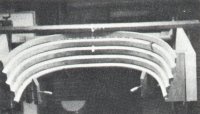 |
COMPLETED?--This hulking shape on a rack in a dark corner of the basement, plus arriving shipments from electrical product and organ manufacturers, lead wife Val Bauscher to suspect that the show is not yet over. |
Visiting artists often stopped by to play the Bauscher Wurlitzer. Tony Fenelon, from Australia, visited in the Fall of 1969.
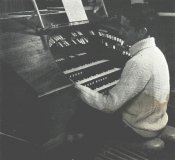
Tony Fenelon, c. 1969
|




![]() Editor's Note: Various articles about the instrument (including the one below) list the Wurlitzer opus number as 1709. This disagrees with the Judd Walton Opus List which shows the World Theatre instrument as opus 530. It shows opus 1709 going to the Orpheum Theatre (also in Omaha). In a letter to the Editor of Theatre Organ (February 1970), Judd Walton himself also calls into question the accuracy of opus #1709. He states that the correct opus number is #530.
Editor's Note: Various articles about the instrument (including the one below) list the Wurlitzer opus number as 1709. This disagrees with the Judd Walton Opus List which shows the World Theatre instrument as opus 530. It shows opus 1709 going to the Orpheum Theatre (also in Omaha). In a letter to the Editor of Theatre Organ (February 1970), Judd Walton himself also calls into question the accuracy of opus #1709. He states that the correct opus number is #530.










